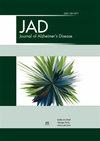颈动脉斑块与阿尔茨海默病脑脊液生物标志物及认知功能之间的关系:CABLE 研究
IF 3.4
3区 医学
Q2 NEUROSCIENCES
引用次数: 0
摘要
背景:最近有报道称,颈动脉斑块与认知能力下降之间存在关联。然而,目前的研究证据不足,认知能力变化的可能原因尚不清楚。研究目的本研究旨在探讨认知功能正常的成年人颈动脉斑块与认知功能、脑脊液(CSF)阿尔茨海默病(AD)生物标志物之间的关系,并尝试研究其潜在机制。研究方法我们从中国阿尔茨海默病生物标志物与生活(CABLE)研究中招募了165名认知正常的参与者,对他们进行了脑脊液AD生物标志物测量和颈动脉超声检查。研究采用线性模型评估颈动脉斑块与脑脊液生物标志物和认知能力之间的关系。此外,还通过10,000次引导迭代进行了中介分析,以探索颈动脉斑块、AD病理和认知之间的潜在联系。结果:我们发现颈动脉斑块与 Aβ42 (β = -1.173, p = 0.022)、Aβ42/Aβ40 (β = -0.092, p < 0.001)、P-tau/Aβ42 (β = 0.110, p = 0.045)和 T-tau/Aβ42 (β = 0.451, p = 0.010)呈显著相关。通过中介分析发现,颈动脉斑块对认知功能的影响可由Aβ42/Aβ40(中介比例=55.8%)、P-tau/Aβ42(中介比例=51.6%,p=0.015)和T-tau/Aβ42(中介比例=43.8%,p=0.015)中介。结论这项研究表明,在认知功能完好的成年人中,颈动脉斑块与脑脊液中的注意力缺失症生物标志物之间存在联系,而且注意力缺失症病理学可能在颈动脉斑块与认知变化之间的相关性中扮演重要角色。本文章由计算机程序翻译,如有差异,请以英文原文为准。
Association Between Carotid Plaque and Alzheimer’s Disease Cerebrospinal Fluid Biomarkers and Cognitive Function in Cognitively Intact Adults: The CABLE Study
Background: The association between carotid plaque and cognitive decline has recently been reported. However, the current research evidence is insufficient, and the possible causes of cognitive changes are unknown. Objective: This study aims to explore the relationships between carotid plaque and cognition functions, cerebrospinal fluid (CSF) Alzheimer’s disease (AD) biomarkers in cognitively intact adults, and try to study the underlying mechanisms. Methods: We enrolled 165 cognitively normal participants from the Chinese Alzheimer’s Biomarker and LifestylE (CABLE) study, who had CSF AD biomarker measurements and carotid ultrasound. Linear modeling was used to assess the association of carotid plaque with CSF biomarkers and cognition. Additionally, mediation analysis was conducted through 10,000 bootstrapped iterations to explore potential links between carotid plaque, AD pathology, and cognition. Results: We found that carotid plaque exhibited significant correlations with Aβ42 (β = –1.173, p = 0.022), Aβ42/Aβ40 (β = –0.092, p < 0.001), P-tau/Aβ42 (β = 0.110, p = 0.045), and T-tau/Aβ42 (β = 0.451, p = 0.010). A significant correlation between carotid plaque and cognition decline was also found in men (β = –0.129, p = 0.021), and mediation analyses revealed that the effect of carotid plaque on cognitive function could be mediated by Aβ42/Aβ40 (proportion of mediation = 55.8%), P-tau/Aβ42 (proportion of mediation = 51.6%, p = 0.015) and T-tau/Aβ42 (proportion of mediation = 43.8%, p = 0.015) mediated. Conclusions: This study demonstrated the link between carotid plaque and CSF AD biomarkers in cognitively intact adults, and the important role that AD pathology may play in the correlation between carotid plaque and cognitive changes.
求助全文
通过发布文献求助,成功后即可免费获取论文全文。
去求助
来源期刊

Journal of Alzheimer's Disease
医学-神经科学
CiteScore
6.40
自引率
7.50%
发文量
1327
审稿时长
2 months
期刊介绍:
The Journal of Alzheimer''s Disease (JAD) is an international multidisciplinary journal to facilitate progress in understanding the etiology, pathogenesis, epidemiology, genetics, behavior, treatment and psychology of Alzheimer''s disease. The journal publishes research reports, reviews, short communications, hypotheses, ethics reviews, book reviews, and letters-to-the-editor. The journal is dedicated to providing an open forum for original research that will expedite our fundamental understanding of Alzheimer''s disease.
 求助内容:
求助内容: 应助结果提醒方式:
应助结果提醒方式:


